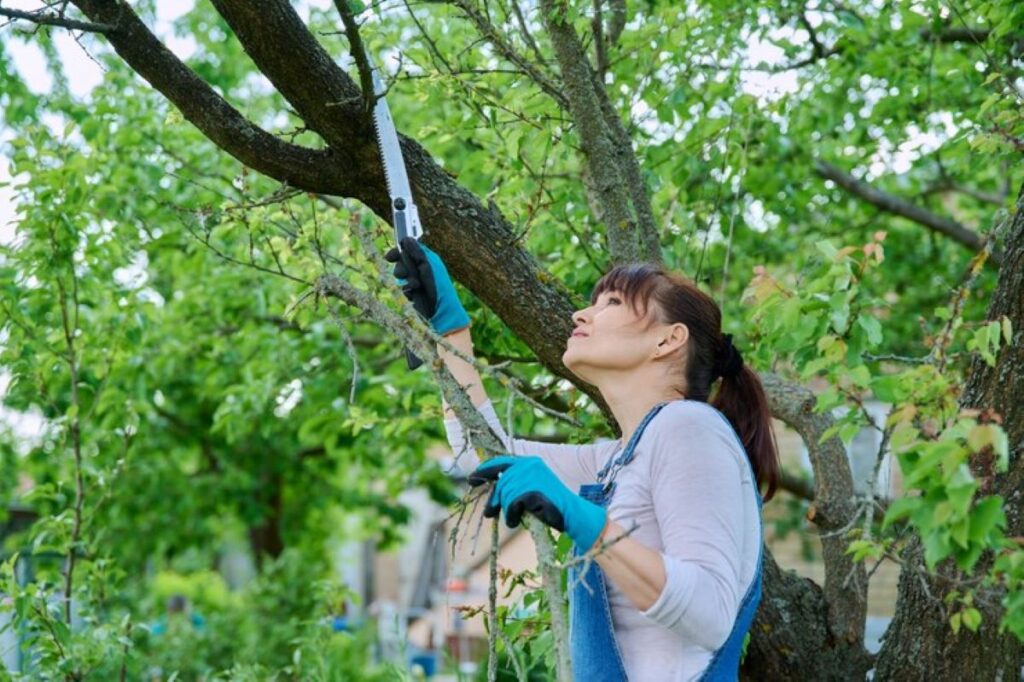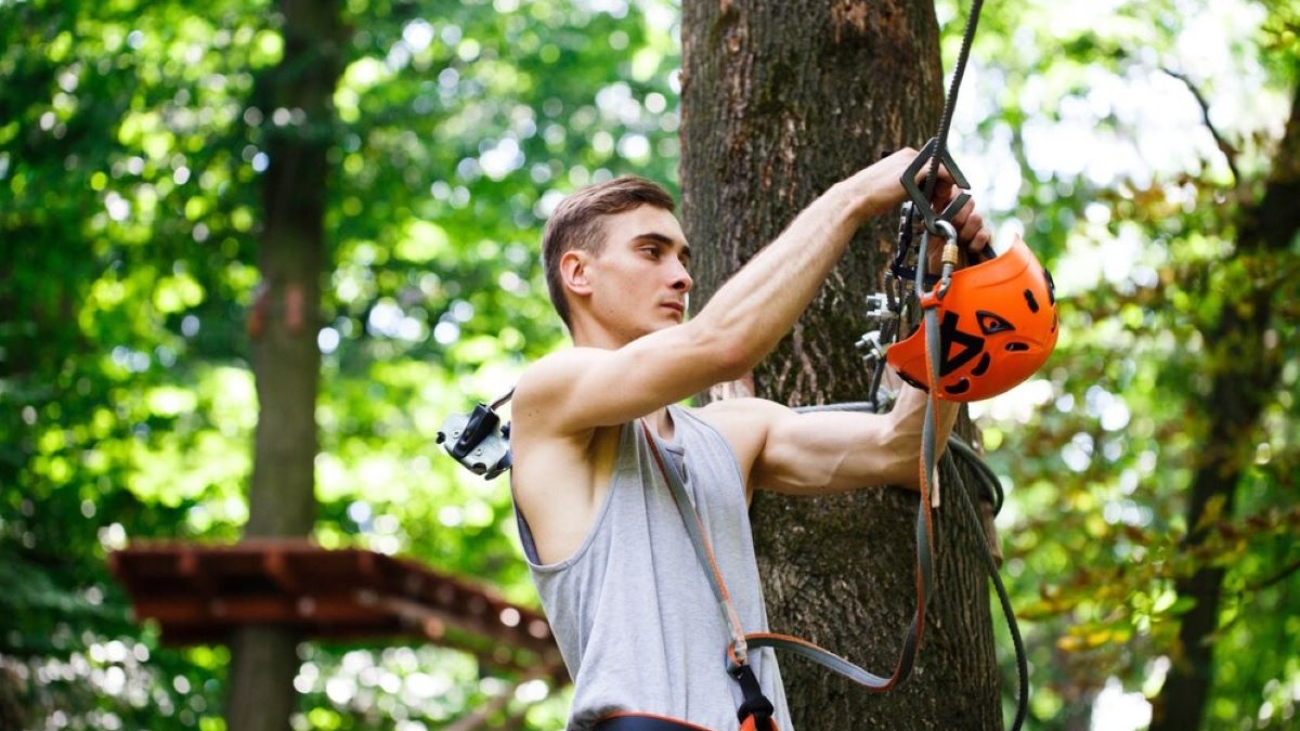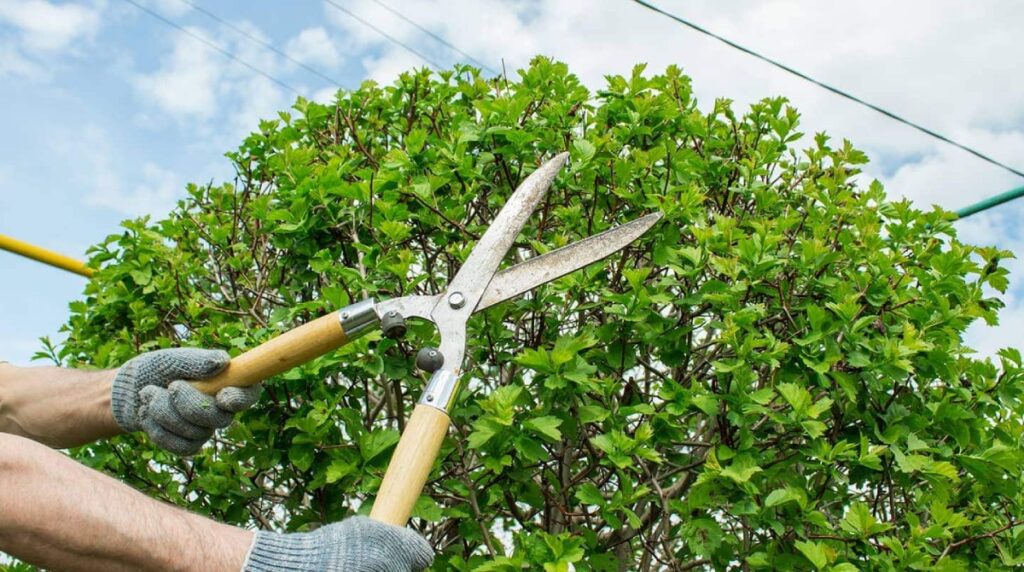What Does Balancing Light and Shade Mean in Tree Care?
How Can Pruning Techniques Optimize Light Penetration and Canopy Density Management?
Crown thinning is the main technique used to improve light penetration while keeping trees healthy. This method involves carefully removing branches from different parts of the canopy, creating openings that allow sunlight to pass through while still maintaining the tree’s natural shape and structure.
Certified arborists use various targeted methods to effectively manage canopy density:
- Selective branch removal focuses on interior branches that compete for space and resources
- Crown raising removes lower branches to increase light reaching plants at ground level
- Directional pruning guides growth patterns to optimise light distribution in specific areas of the landscape
- Structural pruning addresses the “3 C’s” – crossing, competing, and crowded branches
The benefits of pruning go beyond just managing light. Proper control of canopy density promotes air circulation, reducing moisture buildup that often leads to fungal diseases. Each cut serves a dual purpose: improving light access while also strengthening the tree’s structure.
Arborists calculate how much foliage needs to be removed, usually limiting thinning to 15-25% of the canopy in one session. This careful approach prevents stress on the tree while still achieving significant improvements in light penetration. Dense canopies in Roseville’s Mediterranean climate can trap heat and humidity, creating conditions that are favourable for pests and diseases.
It’s important to consider the relationship between canopy density and photosynthesis. Removing too much foliage can harm the tree’s ability to produce energy, but keeping growth overly dense blocks sunlight from reaching inner leaves. Professional arborists find this balance by using their knowledge about different species and precise cutting techniques that respect each tree’s unique growth patterns and environmental needs.
When Is the Best Time to Prune Trees in Roseville for Optimal Light and Shade Balance?
Winter pruning and early spring pruning are the best times to achieve the perfect balance of light and shade in Roseville. During these periods when trees are not actively growing, they experience minimal stress from cutting. This allows arborists to have a clear view of the branch structure without any leaves blocking their sight, enabling them to make precise decisions about which limbs to remove.
Advantages of Pruning During Dormancy
The dormant season offers several benefits when it comes to deciding when to prune:
- Trees conserve energy during winter, redirecting resources to healing wounds rather than supporting active growth
- Bare branches reveal crossing, competing, or crowded limbs that compromise light distribution
- Reduced sap flow minimises bleeding in species susceptible to excessive moisture loss
- Wounds seal more effectively before the growing season begins
Importance of Pest Risk Reduction
Pest risk reduction is another important factor in choosing the right time to prune. Many destructive insects are inactive during the colder months, which greatly reduces the chances of infestation through fresh cuts. Beetles, borers, and other pests that typically attack wounded tissue remain dormant or absent during winter.
Minimising Disease Threats
Diseases also pose less of a threat during dormancy. Fungal spores spread less easily in cold, dry conditions compared to warm, humid periods. By pruning before spring growth begins, we can prevent pathogens from entering vulnerable tissue when trees are most susceptible to infection. This protects our investment in professional tree care.
How Do Certified Arborists Determine the Right Pruning Approach for Each Tree Species?
Tree assessment forms the foundation of every pruning decision. Certified arborists begin by evaluating the tree’s current health, structural integrity, and growth patterns before making any cuts. This comprehensive examination reveals potential issues that might not be visible to untrained eyes.
Understanding Species-Specific Pruning Requirements
Species-specific pruning requirements vary dramatically between different tree types. An oak responds differently to pruning than a eucalyptus or ornamental flowering tree. Arborists consider each species’ natural growth habit, wood density, and healing capacity when planning their approach. For detailed guidelines on tree maintenance along roadsides in Florida, which can provide insight into species-specific needs.
Key Factors in Determining the Right Pruning Method
Key factors in determining the right pruning method include:
- Tree age and maturity level – Young trees need structural pruning whilst mature specimens require maintenance cuts
- Current canopy density – Dense canopies may need thinning whilst sparse growth requires careful selective pruning
- Branch architecture – Natural branching patterns dictate which limbs to remove or retain
- Health status – Diseased or stressed trees demand gentler intervention
- Location and purpose – Trees near structures or power lines need different treatment than those in open spaces
- Seasonal growth patterns – Some species tolerate heavy pruning whilst others require minimal intervention
The arborist’s expertise in balancing light and shade with expert pruning ensures each tree receives customised care. This individualised assessment prevents over-pruning damage whilst achieving optimal light distribution throughout the canopy. Proper species identification allows arborists to predict how the tree will respond to specific cuts, ensuring long-term health and structural stability.
For more comprehensive information on tree pruning techniques, including scientific insights and practical advice, refer to this resource.
What Are the Key Pruning Techniques Used by Professionals to Achieve a Harmonious Balance of Light and Shade?
Professional tree surgeons use crown thinning as their main method for optimising light distribution throughout a tree’s canopy. This technique involves selectively removing specific branches to increase light penetration and air circulation while preserving the tree’s natural shape and structural integrity.
How Crown Thinning Works
Crown thinning targets interior branches strategically, creating openings that allow sunlight to filter through multiple canopy layers. The technique reduces density without compromising the tree’s protective outer shell, ensuring the bark remains shielded from sudden sun exposure that could cause damage.
The 3 C’s Removal Method
Tree surgeons systematically identify and remove branches following the 3 C’s principle:
- Crossing branches that rub against each other, creating wounds vulnerable to disease
- Competing branches that grow parallel and vie for the same growing space
- Crowded branches that cluster too densely, blocking light and restricting air movement
This targeted approach prevents weak branch unions that could fail during storms whilst promoting even light distribution across the entire canopy.

Selective Branch Removal
Experienced tree surgeons never remove more than 15-20% of a tree’s living crown in a single session. Each cut is made at the branch collar using proper technique to encourage natural healing. The selection process considers:
- Branch diameter and position within the canopy
- Growth direction and future development potential
- Impact on the tree’s overall balance and weight distribution
- Specific light requirements of understory plants below
These precision techniques create a canopy that filters light effectively, supporting photosynthesis in lower branches whilst casting dappled shade that benefits the surrounding landscape.
How Often Should Trees Be Pruned to Sustain a Healthy Equilibrium Between Light and Shade Over Time?
Pruning frequency depends entirely on the tree’s age and development stage. Young trees require initial structural pruning within two years of planting to establish a strong framework that supports proper light distribution throughout their lifespan.
Recommended ongoing maintenance intervals:
- Newly planted trees (0-2 years): Structural pruning within the first two years to develop proper form
- Establishing trees (3-10 years): Annual inspections with pruning every 2-3 years to guide growth patterns
- Mature trees (10+ years): Professional assessment every 3-5 years with pruning as needed
These intervals ensure consistent canopy management without over-pruning, which can stress trees and compromise their natural defence systems. Certified arborists in Roseville adjust these schedules based on species-specific growth rates, with fast-growing varieties like eucalyptus requiring more frequent attention than slower-growing natives.
Regular pruning prevents the accumulation of dense foliage that blocks essential light from reaching lower branches and understory plants. Trees pruned on schedule maintain better structural integrity, reducing the need for corrective work later. Each pruning session builds upon previous work, gradually refining the canopy’s light-filtering properties whilst preserving the tree’s natural architecture.
Seasonal considerations also influence timing, with most maintenance scheduled during dormant periods to minimise stress and disease transmission risks.
What Tools and Methods Do Professional Arborists Use to Ensure Safe and Effective Pruning Practices?
Professional arborists use specialised equipment designed to make precise cuts while protecting tree health. The right tools for pruning include hand pruners for branches up to 2cm in diameter, loppers for stems up to 5cm, and pruning saws for larger limbs.
Sharp, clean blades are essential—dull tools crush tissue instead of cutting cleanly, creating entry points for pathogens. Certified arborists sterilise equipment between trees to prevent disease transmission.
For higher branches, pole pruners extend reach without needing ladders, while professional-grade chainsaws handle substantial structural work. Safety gear includes helmets, eye protection, and cut-resistant gloves.
Preventing damage starts with understanding proper cutting techniques. Arborists make cuts just outside the branch collar—the swollen area where branches meet the trunk—allowing trees to seal wounds naturally. Three-cut methods prevent bark tearing on heavy limbs.
Expert pruning services in Roseville balance light and shade by focusing on precision rather than speed. They carefully choose specific branches to improve light distribution while preserving the overall structure. Each cut is strategically planned as part of the canopy management strategy.
How Expert Pruning By Roseville Arborists Enhances The Overall Beauty And Safety Of Landscapes
Professional pruning transforms landscapes by creating balanced, visually striking trees whilst eliminating dangerous structural weaknesses. Certified arborists sculpt canopies to reveal natural branch architecture, allowing dappled sunlight to filter through whilst maintaining the tree’s characteristic form.
Aesthetic Improvement
Aesthetic improvement stems from strategic branch removal that enhances a tree’s natural shape. Arborists eliminate awkward crossing branches, reduce dense clusters that create visual heaviness, and open sight lines to showcase attractive bark patterns and branch structures. This careful shaping allows gardens beneath to flourish with filtered light, creating layered landscapes where shade-tolerant plants thrive alongside sun-loving specimens.
Safety Through Pruning
Safety through pruning addresses immediate hazards before they become emergencies. Overgrown branches extending over rooflines, pathways, or power lines pose significant risks during Roseville’s occasional storms. Dead wood hidden within dense canopies can fall without warning, threatening property and people below.
Professional arborists identify and remove:
- Weak branch unions where poor attachment points create failure risks
- Overextended limbs that strain under their own weight
- Diseased sections that compromise structural integrity
- Conflicting branches that rub and create entry points for pathogens
Proper pruning also prevents future problems by establishing strong frameworks in young trees and maintaining balanced weight distribution in mature specimens. Reduced wind resistance through selective thinning helps trees withstand weather events, whilst improved air circulation minimises fungal disease risks that thrive in stagnant, shaded conditions.
The combination of enhanced visual appeal and proactive hazard reduction creates outdoor spaces where families can enjoy their gardens with confidence, knowing their trees contribute beauty without compromising safety.
Why Should You Choose A Professional Arborist In Roseville For Balancing Light And Shade Through Expert Pruning?
Professional arborists bring specialized knowledge that transforms your landscape through precise light and shade management. When you choose professional arborist Roseville services, you gain access to certified expertise that protects your investment whilst enhancing property aesthetics.
Qualified arborists understand how to balance light and shade with expert pruning through species-specific techniques. They assess individual tree needs, considering growth patterns, health status, and environmental factors unique to your property. This personalized approach prevents costly mistakes that untrained pruning often creates.

Key advantages include:
- Risk mitigation through proper branch removal techniques that prevent structural damage
- Long-term tree health maintained through strategic canopy management
- Enhanced property value resulting from professionally maintained landscapes
- Safety assurance with proper equipment and insurance coverage
- Time efficiency as experienced arborists complete work faster without compromising quality
Certified professionals also recognize disease symptoms and pest issues during pruning assessments. Early detection saves trees that might otherwise decline or require removal. Their systematic approach to crown thinning and structural pruning creates sustainable light distribution patterns that benefit your entire landscape ecosystem.
Ready to transform your outdoor space? Contact a certified Roseville arborist today for a comprehensive tree assessment. Professional consultation identifies opportunities to optimize light penetration whilst preserving the natural beauty and structural integrity of your trees. Your landscape deserves expert care that balances immediate aesthetics with long-term tree vitality.
More to Read : Arborist Thornleigh how to identify termite damage before it spreads
FAQs About Balancing Light and Shade in Tree Care
It refers to maintaining a canopy structure that allows enough sunlight for healthy growth while preserving shade to protect the landscape and maintain comfort beneath the tree.
2. Why is balancing light and shade important for tree health?
Proper light balance enhances photosynthesis, strengthens tree structure, improves air circulation, and prevents disease by reducing moisture buildup within the canopy.
3. How do arborists achieve the right balance between light and shade?
Certified arborists use expert pruning techniques such as crown thinning, selective branch removal, and directional pruning to optimise light penetration and air flow.
4. When is the best time to prune trees in Roseville?
Winter and early spring are ideal, as trees are dormant, pests are inactive, and pruning during this time minimises stress and disease risks.
5. How often should trees be pruned to maintain healthy light and shade balance?
Young trees need pruning every 2–3 years, while mature trees typically require maintenance every 3–5 years, depending on species and growth rate.
6. What pruning methods help control canopy density?
Crown thinning, crown raising, and structural pruning address overcrowded branches, allowing light to filter through while keeping trees strong and stable.
7. What tools do professional arborists use for safe pruning?
Arborists use hand pruners, loppers, pole saws, and chainsaws, combined with safety gear and sterilised equipment to ensure clean cuts and prevent disease spread.
8. How does expert pruning enhance landscape aesthetics and safety?
It creates visually balanced trees, prevents overgrowth near structures, reduces storm damage risks, and improves the overall beauty and safety of outdoor spaces.
9. Why should you hire a certified arborist in Roseville for light and shade management?
Professional arborists provide species-specific care, ensure compliance with safety standards, and deliver lasting results that protect both tree health and property value.




